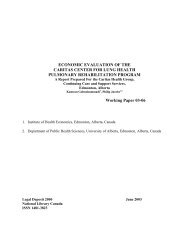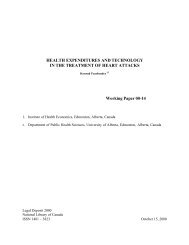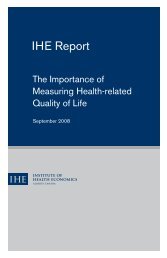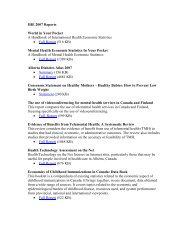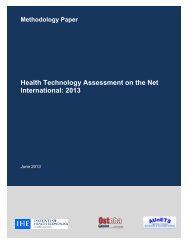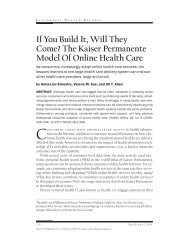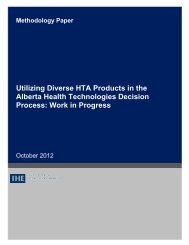Overview <strong>of</strong> <strong>adult</strong> <strong>obesity</strong>Over the past 30 years, <strong>obesity</strong> has become one <strong>of</strong> the most prevalent conditions in countries withdeveloped market economies. It is now recognized as a major public health problem and has beenidentified as an epidemic by the World <strong>Health</strong> Organization and medical organizations around theglobe.Adult <strong>obesity</strong> has emerged as a chronic medical condition characterized by an accumulation <strong>of</strong>excess body fat caused by a long-term energy imbalance that mainly results from a complexinteraction <strong>of</strong> biological, environmental, and behavioural factors.In practice, <strong>adult</strong> <strong>obesity</strong> is defined according to body mass index (BMI), with a BMI <strong>of</strong> 30–34.9kg/m 2 , 35–39.9 kg/m 2 , and 40 kg/m 2 or greater corresponding to mild (class I) <strong>obesity</strong>, moderate(class II) <strong>obesity</strong>, and severe/extreme/morbid (class III) <strong>obesity</strong>, respectively. Because BMI is anindirect measure <strong>of</strong> body composition, a measure <strong>of</strong> central adiposity (that is, waist circumference) isalso recommended as a screening and diagnostic test <strong>for</strong> <strong>adult</strong> <strong>obesity</strong>, to assess more accurately thelevel <strong>of</strong> cardiometabolic risk.Obesity is regarded as a health problem because it is associated with multiple organ-specific andpsychosocial consequences that may result in reduced quality <strong>of</strong> life, increased morbidity, andpremature mortality. The most serious adverse health risks and consequences are associated withsevere (class III) <strong>obesity</strong>.Epidemiology <strong>of</strong> <strong>adult</strong> <strong>obesity</strong>In Canada, as in other countries with developed market economies, the prevalence <strong>of</strong> <strong>obesity</strong> hasincreased steadily within all demographic groups over the past few decades and continues to rise.Class II and class III <strong>obesity</strong> subgroups are experiencing the most rapid increase. The determinants<strong>of</strong> this rapid rise in <strong>obesity</strong> prevalence are many and their complex interactions are still poorlydefined. Obesity prevalence among children and adolescents is increasing at a more rapid pace thanis <strong>adult</strong> <strong>obesity</strong>, causing concern.Self-reported data from surveys <strong>of</strong> nationally representative samples <strong>of</strong> Canadian <strong>adult</strong>sshowed a steady increase in the prevalence <strong>of</strong> <strong>adult</strong> <strong>obesity</strong>, from 6.1% in 1985 to 15.7% in2003 and 17% in 2007. The proportion <strong>of</strong> <strong>adult</strong>s with class II <strong>obesity</strong> increased from 0.8% in1985 to 3% in 2003, and in class III the proportion increased from 0.4% to 1.3%. Directly measured data, which are considered more accurate than self-reported data, suggestthat the prevalence <strong>of</strong> <strong>adult</strong> <strong>obesity</strong> has almost doubled during the past several decades,increasing from 13.8% in 1978–1979 to 23.1% in 2004. The prevalence <strong>of</strong> class II <strong>obesity</strong>increased from 2.3% in 1978–1979 to 5.1% in 2004, while class III <strong>obesity</strong> rates increasedfrom 0.9% to 2.7%.According to the most recently released prevalence rates <strong>for</strong> <strong>adult</strong> <strong>obesity</strong> in Alberta, amongAlberta’s 2007 population <strong>of</strong> 2,619,032 <strong>adult</strong>s (aged 18 years and over), 17.7% were classified asobese (12.5% in class I, 3.7% in class II, and 1.5% in class III <strong>obesity</strong>), based on self-reported datafrom the 2007 CCHS.Women were less likely than men to be classified as obese (15.9% and 19.5%, respectively).<strong>Bariatric</strong> <strong>treatments</strong> <strong>for</strong> <strong>adult</strong> <strong>obesity</strong> 38
Obesity rates increased with age, from 8.1% among <strong>adult</strong>s aged 18 to 24 years to the peak at23.5% among individuals aged 55 to 64 years. The proportion <strong>of</strong> <strong>obesity</strong> drops among theelderly (those over 65 years <strong>of</strong> age).Albertans who are high school graduates are less likely than those who did not graduatefrom high school to be classified as obese (17.2% and 22.5%, respectively).Obesity prevalence rates were higher <strong>for</strong> married and widowed <strong>adult</strong>s (over 19%) than <strong>for</strong>single persons (12.4%) The relationship between <strong>obesity</strong> rates and household annual income did not vary in a linearfashion. Obesity rates were lower (approximately 16%) <strong>for</strong> those in income categories <strong>of</strong> lessthan $20,000 or between $40,000 and $59,000, and higher <strong>for</strong> those with incomes between$20,000 and $39,000 (17.7%) or between $60,000 and $70,000 (19.2%). The highest <strong>obesity</strong>rate (21.6%) was observed in individuals with incomes <strong>of</strong> more than $80,000. Obesity rates were lower in the Edmonton and Calgary zones (17.7% and 14.2%,respectively) than in other health zones in the province, where the rates ranged from 20% to25%.The latest directly measured <strong>adult</strong> <strong>obesity</strong> prevalence rates <strong>for</strong> Alberta were obtained from 2004CCHS data. In 2004, the <strong>adult</strong> <strong>obesity</strong> rate <strong>for</strong> Alberta was 25.2%, with the rates <strong>for</strong> classes I, II, andIII <strong>obesity</strong> being 15.4%, 6.7%, and 3.2%, respectively.Patterns <strong>of</strong> careGiven that long-term maintenance <strong>of</strong> weight loss is difficult to achieve once an individual becomesobese, both prevention strategies (to keep more individuals from becoming obese) and bariatrictreatment strategies (to assist those diagnosed with <strong>obesity</strong> in losing excess weight and keeping it <strong>of</strong>fpermanently) should be considered when addressing <strong>obesity</strong>. A comprehensive and multisectoralapproach to <strong>obesity</strong> prevention is recommended, and effective action requires addressing thecommercial, environmental, and social policy drivers <strong>of</strong> <strong>obesity</strong>. <strong>Health</strong>y behaviours need to besupported by public health measures, such as supportive environments and effective policy changesthat promote healthy weight and prevent <strong>obesity</strong> and its related health risks and consequences.<strong>Bariatric</strong> treatment <strong>for</strong> <strong>adult</strong>s with <strong>obesity</strong>Evidence-based recommendations suggest that bariatric care <strong>for</strong> <strong>adult</strong>s with <strong>obesity</strong> should addressboth the medical and the psychological burdens <strong>of</strong> <strong>obesity</strong>, and include prevention <strong>of</strong> further weightgain. A weight management program based on lifestyle and behavioural modification that includesdietary changes, increased physical activity, and behavioural therapy remains the cornerstone <strong>of</strong>effective bariatric care <strong>for</strong> <strong>adult</strong> <strong>obesity</strong>. Realistic weight loss goals must be clearly defined with theaffected individual, and the treatment plan should be individually tailored based on age, gender,degree <strong>of</strong> <strong>obesity</strong>, individual health risks, cardiometabolic and psychobehavioural characteristics, andoutcome <strong>of</strong> previous weight loss attempts. Pharmacotherapy may be added if lifestyle andbehavioural modification alone are insufficient to achieve clinically significant weight loss. <strong>Bariatric</strong>surgery combined with long-term lifestyle modification may be an appropriate option <strong>for</strong> <strong>adult</strong>s withsevere and moderate <strong>obesity</strong> (when BMI reaches 40 kg/m 2 and even 35 kg/m 2 if it is associated withcomorbidities) who do not respond to appropriate nonsurgical approaches.The therapeutic approach to <strong>adult</strong> <strong>obesity</strong> is multifaceted and complex, particularly <strong>for</strong> severe<strong>obesity</strong>, and is based on intensive patient education and counseling about improving dietary patterns,<strong>Bariatric</strong> <strong>treatments</strong> <strong>for</strong> <strong>adult</strong> <strong>obesity</strong> 39
- Page 1 and 2:
Alberta STE ReportBariatric treatme
- Page 3 and 4:
Alberta STE ReportBariatric treatme
- Page 5 and 6:
EXECUTIVE SUMMARYSocial and System
- Page 7 and 8:
Three surgical procedures—adjusta
- Page 9:
Costs of Bariatric Surgery and Pote
- Page 12 and 13: Regulatory status .................
- Page 14 and 15: TABLES AND FIGURESSection One: Soci
- Page 16 and 17: ABBREVIATIONSAll abbreviations that
- Page 18 and 19: LYMmMAMDMUHCNANHLBINHSNICENIHNNHNPH
- Page 20 and 21: Bariatric physician: a licensed Doc
- Page 22 and 23: High-density lipoprotein (HDL): a f
- Page 24 and 25: Very-low-calorie diet (VLCD): a die
- Page 26 and 27: Additional Internet searches were c
- Page 28 and 29: This report addresses obesity in ad
- Page 30 and 31: Many systemic factors have been ide
- Page 32 and 33: Severe obesity is associated with d
- Page 34 and 35: eport their height and under-report
- Page 36 and 37: Also using self-reported data from
- Page 38 and 39: An examination of overall obesity d
- Page 40 and 41: Table S.2 presents the associationa
- Page 42 and 43: • have multiple focal points and
- Page 45 and 46: The main problem in any weight mana
- Page 47: food, and a negative body image. As
- Page 50 and 51: directly causes death. 61 To the ex
- Page 52 and 53: The addition of a selected pharmaco
- Page 54 and 55: lack of formal training in nutritio
- Page 56 and 57: slightly more likely to have prescr
- Page 58 and 59: selection criteria, have facilities
- Page 60 and 61: Barriers to using appropriate baria
- Page 64 and 65: the need for regular physical activ
- Page 66 and 67: phenylpropanolamine/25. Sibutramine
- Page 68 and 69: Complianceand AdherenceDemand andut
- Page 70 and 71: Aetna Clinical PolicyBulletinswww.a
- Page 72 and 73: Overweight 123,821 172,971 157,623
- Page 74 and 75: REFERENCES1. 2006 Canadian clinical
- Page 76 and 77: 34. Gostin LO. Fast and supersized:
- Page 78 and 79: 69. Klarenbach S, Padwal R, Wiebe N
- Page 80 and 81: 105. Hill JO, Thompson H, Wyatt H.
- Page 82 and 83: 141. Ross R, Bradshaw AJ. The futur
- Page 84 and 85: 172. Arkinson J, Ji H, Fallah S, Pe
- Page 86 and 87: This section will address a set of
- Page 88 and 89: dietary therapy is to reduce total
- Page 90 and 91: Additional benefits of exercise ove
- Page 92 and 93: medications that inhibit intestinal
- Page 94 and 95: Rimonabant may be considered for pa
- Page 96 and 97: Long-term complications are specifi
- Page 98 and 99: Devices used for bariatric surgeryH
- Page 100 and 101: Description of the Included Systema
- Page 102 and 103: AEs for sibutramineAs compared to a
- Page 104 and 105: Evidence on Efficacy/EffectivenessW
- Page 106 and 107: Table T.7: Effects of behavioural t
- Page 108 and 109: SurgeryDescription of the included
- Page 110 and 111: follow-up time was 3 years. Results
- Page 112 and 113:
group as compared to the VBG group.
- Page 114 and 115:
The authors identified many methodo
- Page 116 and 117:
The investigators pointed out that
- Page 118 and 119:
approximately 3 to 5 kilograms. For
- Page 120 and 121:
for studies with a mean age of part
- Page 122 and 123:
Examining whether use of any of the
- Page 124 and 125:
Evidence from placebo-controlled cl
- Page 126 and 127:
colorectal or gastroesophageal or f
- Page 128 and 129:
Web of ScienceISI Interface License
- Page 130 and 131:
AMA Clinical PracticeGuidelineswww.
- Page 132 and 133:
critical appraisal of the included
- Page 134 and 135:
APPENDIX T.B: EXCLUDED STUDIESTable
- Page 136 and 137:
Padwal R, Li SK, Lau DC. Long-term
- Page 138 and 139:
Quality subsection 1: At least MEDL
- Page 140 and 141:
Quality subsection 5a:Study quality
- Page 142 and 143:
Partially reported: The study types
- Page 144 and 145:
Table T.C.1: Results of quality ass
- Page 146 and 147:
Table T.C.1: Results of quality ass
- Page 148 and 149:
APPENDIX T.D: CHARACTERISTICS OF SY
- Page 150 and 151:
Table T.D.1: Characteristics of the
- Page 152 and 153:
Table T.D.1: Characteristics of the
- Page 154 and 155:
Table T.D.2: Characteristics of the
- Page 156 and 157:
APPENDIX T.E: EVIDENCE TABLE ON SAF
- Page 158 and 159:
Serious surgical complicationsSurgi
- Page 160 and 161:
LSGmMAMDNAnssORQoLRCTRDRRRYGBSBPTGV
- Page 162 and 163:
Table T.F.1-2: Weight loss - Behavi
- Page 164 and 165:
Table T.F.1-4: Weight loss - Surger
- Page 166 and 167:
Table T.F.2: Quality of life (QoL)
- Page 168 and 169:
Curioni & Lourenco 2005 58Cholester
- Page 170 and 171:
Table T.F.3-3: Risk factors/comorbi
- Page 172 and 173:
Table T.F.3-5: Long-term effects of
- Page 174 and 175:
Maciejewski et al., 2005 65Avenell
- Page 176 and 177:
Table T.G.2: Effects of bariatric s
- Page 178 and 179:
Table T.G.4: Effects of bariatric s
- Page 180 and 181:
18. Cerulli J, Lomaestro BM, Malone
- Page 182 and 183:
50. Health Canada Drug Product Data
- Page 184 and 185:
SECTION THREE: ECONOMIC EVALUATIONC
- Page 186 and 187:
Definition of bariatric surgical pa
- Page 188 and 189:
etween surgical interventions, the
- Page 190 and 191:
concluded that adding orlistat to L
- Page 192 and 193:
Weight management program (WMP) ver
- Page 194 and 195:
groups. Compared with standard care
- Page 196 and 197:
Results from Analysis of Provincial
- Page 198 and 199:
DiscussionThe objectives of the eco
- Page 200 and 201:
surgical suites, and so on. The bud
- Page 202 and 203:
APPENDIX E.A: LITERATURE SEARCH SUM
- Page 204 and 205:
CRD Databases(DARE, HTA & NHS EED)h
- Page 206 and 207:
Web of ScienceISI Interface License
- Page 208 and 209:
NEOS Librarywww.library.ualberta.ca
- Page 210 and 211:
Table E.A.2: Evidence table of revi
- Page 212 and 213:
ResultHealth outcomesCostsMarginal
- Page 214 and 215:
CostsMarginal analysisThe cost anal
- Page 216 and 217:
Time Horizon/discount rateCurrency/
- Page 218 and 219:
Objectivestudy perspective: society
- Page 220 and 221:
ResultHealth outcomesCostsMarginal
- Page 222 and 223:
ResultHealth outcomesCostsMarginal
- Page 224 and 225:
S4Economic burden of obesityMean co
- Page 226 and 227:
15. Lacey LA, Wolf A, O'shea D, Ern
- Page 228 and 229:
Author Contribution StatementsPaula



